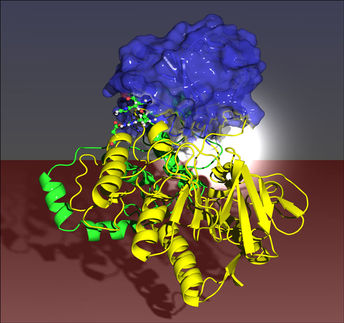Scientists Demystify an Enzyme Responsible for Drug and Food Metabolism
Advertisement
For the first time, scientists have been able to "freeze in time" a mysterious process by which a critical enzyme metabolizes drugs and chemicals in food. By recreating this process in the lab, a team of researchers has solved a 40-year-old puzzle about changes in a family of enzymes produced by the liver that break down common drugs such as Tylenol, caffeine, and opiates, as well as nutrients in many foods. The breakthrough discovery may help future researchers develop a wide range of more efficient and less-expensive drugs, household products, and other chemicals. The scientists' findings are published in the Science.
Michael Green, an associate professor of chemistry at Penn State University and lead author of the study, explained that scientists have speculated for decades that, during the process of metabolizing chemicals in the human liver, enzymes in the family named P450 pass through a critical chemical phase-change called "Compound I," whereby an oxygen molecule is temporarily added. However, until now, no one had actually seen the process happen or even had proven that it existed. "This phase change happens quickly, and P450 just as quickly changes back to its original state," Green explained. "So the challenge was trapping the enzyme at the exact moment that it went through the Compound I stage." First, Green and his colleagues grew one of the P450 enzymes in E.coli - bacteria found in the human gut. They then developed a method to cool the enzyme at just the right rate - one one-thousandth of a second -- to "freeze in time" the formation process of Compound I.
Green also explained that, while all humans have a gene responsible for making the P450 enzymes, different populations of humans vary in which version of the gene they carry, and thus, which version of P450 they produce. Such P450 variations lead to differences in the way people respond to particular drugs. "With a drug such as caffeine, for example, one population of people might be fast metabolizers, while another might metabolize the drug more slowly," Green explained. "Because the risk of caffeine-induced heart attack may be higher in slow metabolizers, the ability to actually take a snapshot of the phase changes of the P450 enzymes could help us to understand better how certain chemicals can affect people in vastly different ways."
Green's P40 research may also aid future scientific discoveries in the field of pharmacology. "Adverse drug-drug interactions are a well-known problem," Green explained. "The answer to why some people have bad interactions could be understood at the level of the P450 enzymes and their state changes. Now that we can see those state changes on a molecular level, a deeper investigation is finally possible."



























































